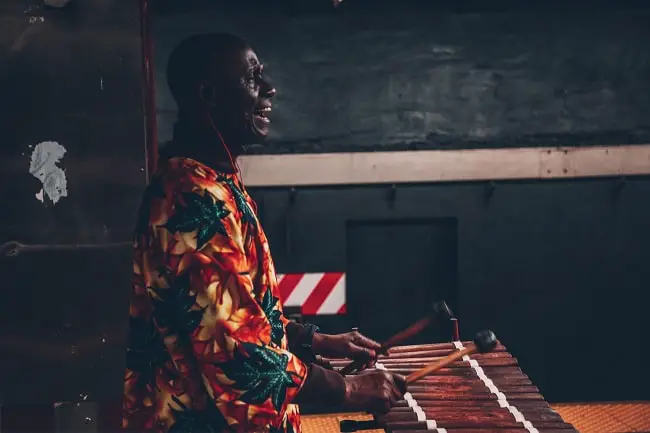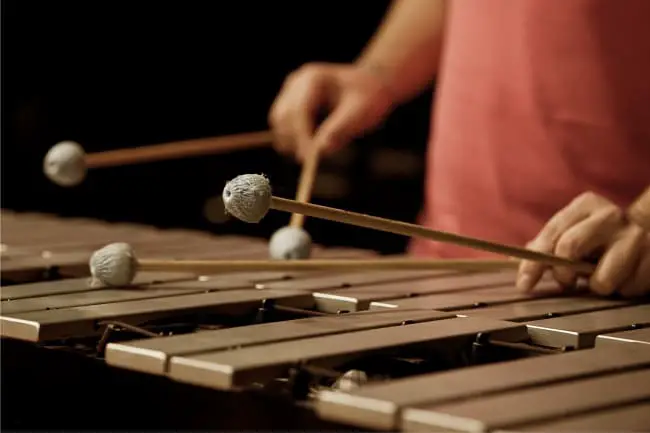You’ve probably heard a xylophone somewhere before — like, who hasn’t? In this article, we’re going to look at the history of the xylophone starting from its beginnings. So, when was the xylophone invented?
Early examples of this instrument have been found across the globe from South East Asia to Africa but it has been commonly accepted that the instrument was invented in Asia over 4000 years ago. It is, however, difficult to pin down exactly which South East Asian country it originated in as documents from this time period in the region are not particularly detailed or accurate.
The name Xylophone comes from the Greek words ‘xylon’ and ‘phone’ which translates as the phrase ‘wood sound’.
It is an instrument in the percussion family which is made up of different lengths of wooden bars which make different sounds when hit with sticks or padded beaters.
The Xylophone in South East Asia
Many experts believe that the first xylophones come from areas of South East Asia or even into island nations in Oceania.
The Vienna Symphonic Library has suggested that the instrument can be traced back to this region as early as 2000BC.
It began as a very basic form with some dried-out logs being placed across the legs of the player or on wooden supports.
Often a pit was dug out below which acted as a kind of resonating chamber, which allowed the sound to echo and project more.
Examples of Asia xylophones include the Thai Ranat and the Indonesian Gambang which are popular across South East Asia.
By the 18th century, the instrument had made its way to nearby China but instead of being used by the native Chinese, they were mainly used by countries that were colonized by China such as Vietnam.
In Japan, a simple version known as a mokkin xylophone was used for music in the famous Kabuki theatre but was played off stage.
It is believed that the instrument came to Japan through the Chinese merchant colony or through the famous teahouses of Nagasaki.
Although xylophones have been present in Asia for centuries, they are not the main instrument or famous from that area.
The Xylophone in Africa
Xylophones are however often linked to the continent of Africa, with the earliest designs being very similar to that of early Asian designs. It is estimated that the instrument reached the continent before the 14th century.
There have been documents found in Mali mentioning the instruments and missionaries from Portugal in the country of Ethiopia reported fancier versions of the instrument in the 16th century.

The African instrument known as the amadinda is made of logs much like its Asian counterpart and has a vibrating membrane which makes the sound have a buzzing tone to it.
It is thought that it was these early African instruments that influenced the development of the marimba in Latin America, due to the movement of people between the two areas during the Slave Trade.
The word marimba can be found in the Bantu language-speaking regions of Africa. The marimba and the xylophone nowadays are described as different instruments as the notes that they play differ in range.
Xylophones traditionally cover between 2 and 4 octaves depending on their size, with their highest note matching that of a piano – a C-88.
A marimba, in contrast, encompasses 2.5 to 4.5 octaves so tends to have a slightly larger range, with C-76 beginning the highest note which is slightly lower.
The marimba is more commonly used as a solo instrument whereas the xylophone is used more commonly within an ensemble.
Many African versions of the instrument stand out as they are different from the instruments that we know today.
When we think of a xylophone, we think of the pitch of the keys increasing as the keys move further to the right.
However, the African version has the pitch increasing outwards from the center, so the highest pitch keys will be on both sides of the instrument.
The idea behind this is that it is more natural for players to move their arms in this way.
One particularly unique xylophone is the Ghanaian Xylophone also known as the Gyil. Traditionally, this instrument was only played by men, partly due to its size of it, and the cultural climate within Ghana.
It can be played as a solo instrument but is often played at the same time as another xylophone to create a unique blend of sounds.
The holes at the bottom of this xylophone are covered in nets made from spider cocoons which lead to a buzzing sound like no other due to the unique vibrations created when playing it.
It is commonly played during funerals of the Dagara people of Northern Ghana and Burkina Faso.
The Xylophone in Europe and America
While Europe may not be the continent of origin for the xylophone, European music and composers have utilized the instrument within their field.
Xylophones were first mentioned in Europe around the 1500s, but they were known by Central Europeans as hölzernes Gelächter or Strohfiedel which translates as ‘wooden percussion’ or ‘straw fiddles’.
It was commonly used in folk music in countries such as Germany and Austria but looked slightly different from the instrument that we know today.
The bars were not displayed in a line in front of the musician, instead, they extended away from them.
The instrument became even more popular in the 19th century due to musicians such as Michal Jozef Guzikov and it was now more widely used as a solo instrument and one played during European Garden Concerts.
By the 19th century, the xylophone was finally introduced to the orchestral world where it still resides today.
The end of World War One was a cause for celebration and dancing was a new craze that hit America and Europe. Dance halls were very popular and many popped up across the continent.
Due to this, music was needed that people could dance to that had a clear beat – and this is where the xylophone came in.
The instrument can be heard in many popular waltz and foxtrot records of the time playing on the beat that people would dance to and ragtime music extended its use even further.
Famous composure George Gershwin used the instrument clearly in his 1935 Opera and many of his other musical pieces.
The Xylophone Today
Nowadays, xylophones tend to have their keys across two rows, similar to that of the piano and they are mounted on a stand that has grooves cut underneath it, which helps reverberate the musical tones around the room.
The two-row xylophone was first introduced in the late 19th century by Albert Roth and they were mass-produced in the early 20th century by American John Calhoun Deagan.
The wood of choice for the instrument is rosewood, however, modern synthetic materials are being used more often.

Performers nowadays often use more than two sticks to add more complexity to the sound that the instrument makes.
Now, players may have two sticks in each hand, making four in total which requires a much higher degree of skill.
There are other instruments that are commonly used today which are similar to the xylophone such as the glockenspiel and vibraphone but these do create slightly different sounds.
Within the United States, there are many Zimbabwean marimba bands that play at the annual Zimbabwean Music Festival where the instrument is still widely celebrated to this day.
But perhaps the most common use of the instrument today is in the classroom, with the xylophone being used to help child development and coordination skills.
Many children start off playing the xylophone to gain knowledge about basic musical beats and concepts before moving on to more complex instruments such as the piano.
Final thoughts
As you can see, we might never really know when was the xylophone invented.
In the end, we can see that the xylophone is a very old instrument. It’s really surprising to learn it has been around since the antiquity period.


